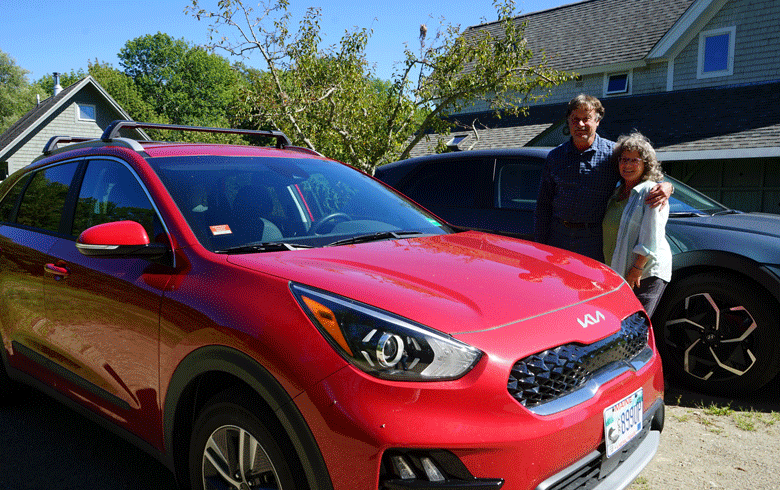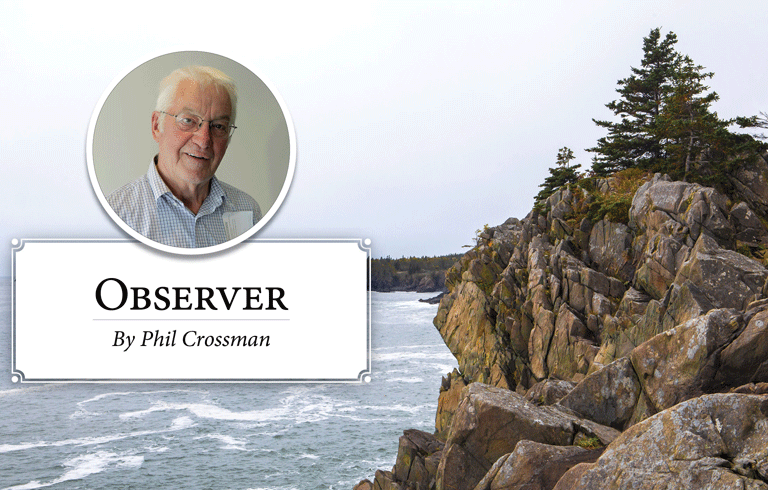You can trace the evolution of cleaner energy solutions over the last 45 years through the lives of Belfast-area couple David Foley and Judy Berk.
Deep-seated values and interests in their professional and personal lives have led to cautious, thoughtful steps toward efficiency and environmental responsibility over those decades. And as Foley says a few times during our conversation on their deck on a late summer day, each step didn’t bring hardship or a sacrifice in quality of life.
That journey began in the late 1980s with what was considered the best way to insulate a new house through today, with the couple now proud owners of two electric vehicles.
Foley is an architect designer, working with his professional partner, Sarah Holland, out of a small office at the homestead in Northport that Berk dubs “Ocean Glimpse Farm.” Berk retired in 2019 after 28 years as communications director for the Natural Resources Council of Maine.
Their move toward energy independence—which has included adding photovoltaic panels to their buildings and, most recently, those electric vehicles—is, as Berk explains it, a matter of their values influencing their work, and their work influencing their values.
“It’s going to percolate up and it’s going to percolate down,” Foley says of the steps they and others have taken to power their lives with electricity.
“We have sun, we have wind, we have falling water, we have biomass,” Foley says. “There’s no reason we can’t do this.”
It’s a move that would have been costly and foolish a few decades ago, but the couple is banking on electricity being the power of choice in a carbon emissions-free world in the coming years.
Berk move to Maine in 1975, moved into an old cannery building in Brooks, west of Belfast, with no insulation, running water, electricity, or phone.
The following year, she landed a job at a small business in Belfast called Alternative Resources, which offered such products as woodstoves, solar power components, and composting toilets. With many young “back-to-the-landers” arriving in Belfast just as the Arab oil embargo drove up energy costs, the time was right.
“I got indoctrinated there,” she says. “All those big old houses in Belfast didn’t have insulation and were heated with oil,” she remembers.
She ended up managing the store and began writing a related column for the Bar Harbor Times, (Belfast) Republican Journal, and Waldoboro Weekly newspapers, called “Power Play.”
That work was followed by a stint with the state, working on energy issues for Waldo and Knox counties. In 1979, Berk managed a $300,000 energy grant through the cooperative extension service using five offices, and Foley was hired the following year to work in the Bangor location, which is how they met.
Foley was raised in Bangor and later Dixmont, and remembers his father, drawing on his Yankee frugality, putting him to work caulking, weather stripping, and insulating the house in Dixmont. The resources in plain sight just need to be tapped, as Mainers have been doing for centuries, he believes.
“We have sun, we have wind, we have falling water, we have biomass,” Foley says. “There’s no reason we can’t do this.”
While attending Dartmouth College, he worked with Vermont’s energy office, and one project included helping dairy farmers find more efficient ways to cool their milk. Foley later earned a master’s degree at the University of California at Berkley.
The couple put down roots in Northport, building their modest but cozy house in 1989, later expanding it so it now includes about 1,650 square feet of living space. They used rigid polyisocyanurate foam, stuffed into the stud and rafter bays, for insulation in the first construction phase. For the addition—after learning about new, better practices—they chose dense-packed cellulose.
It heats with a cord and a half of firewood in the woodstove.
Foley echoes what energy experts often say, that the best investment a homeowner can make is fixes that stop energy waste.
“You start with the efficiency stuff. You don’t unplug one inefficient technology and install another one,” Foley says. “If your refrigerator is harvest gold or avocado, it’s time to get rid of it,” he says with a laugh.
In 2009, they built the architecture office, which is about half the size of the house.
In 2012, they installed 12 photovoltaic panels (PVs) on the roof of the office—which runs computers, printers, copiers, and plotters—then added another 16 in 2015-2016 on an outbuilding.
“There’s zero risk,” Foley says of solar energy.
In 2016 they installed air-source heat pumps.
“The one part of our energy systems we can ‘green up’ is electric,” Foley explains, meaning that relying on electricity to power much of the house and office is to move away from fossil fuels.
In 1996, Foley won a grant to visit Europe for two months to see how Norway, Sweden, the Netherlands, and Germany addressed energy needs. Some 40% to 60% of energy used in Sweden, Denmark, Spain, and Italy comes from renewable sources, he says.
“And life’s good there!” he says with a laugh.
On Facebook, Berk usually posts the couple’s electricity story at the end of the calendar year. Every year since 2012 except one, they essentially had no electric bill, thanks to the PVs on the roof. Net metering allows residents to sell the electricity they produce to the utility company for credit.
That virtually free electricity prompted the couple to consider switching to electric vehicles, and earlier this year, they took the plunge, purchasing a Kia Niro and a Hyundai IONIQ 5. The Kia is a hybrid, so it includes a gasoline engine and a plug-in chargeable battery. The Hyundai is a straight electric, charged by plugging it in.
The Kia gets 50 miles to the gallon of gas, and has a 512-mile range. The Hyundai is rated at 265 miles on a full charge, but they are finding that it can go 330 miles on a charge. The Hyundai also features all-wheel drive.
Berk is proud to report that the all-electric car has passed a Humvee going up a hill, while Foley points out “We can drive 100 miles for $6.40.”
But for Berk, the real test is that she can fit three trash cans and her small kayak in one of the cars, testifying to the lack of sacrifice that comes with this new technology.
“We can’t shoot ourselves in the foot for our values,” Foley says.





